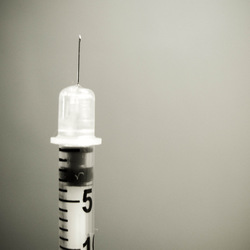Diabetes Mellitus

Simply put, diabetes is a disease in which the body cannot make enough insulin to meet the body’s needs.
Insulin is a hormone produced by specific cells within the pancreas. Insulin is vital to the body as it helps cells absorb the glucose from the blood stream and use it to meet their energy needs. Diabetes occurs when these cells no longer produce enough insulin. When there is not enough insulin, sugar remain in the blood stream at abnormally high levels and yet the cells are starving from a lack of sugar.
Diabetes is generally classified into two types. Type I diabetics (also known as juvenile diabetes) have destroyed pancreatic tissue. Type II diabetics still have cells within the pancreas that can produce insulin but, for a variety of reasons, these cells are “burned out” and unable to produce enough insulin to meet the body’s needs. This burn out happens because factors within the body contribute to a process known as insulin resistance. Cats most commonly develop type II diabetes.
Insulin is a hormone produced by specific cells within the pancreas. Insulin is vital to the body as it helps cells absorb the glucose from the blood stream and use it to meet their energy needs. Diabetes occurs when these cells no longer produce enough insulin. When there is not enough insulin, sugar remain in the blood stream at abnormally high levels and yet the cells are starving from a lack of sugar.
Diabetes is generally classified into two types. Type I diabetics (also known as juvenile diabetes) have destroyed pancreatic tissue. Type II diabetics still have cells within the pancreas that can produce insulin but, for a variety of reasons, these cells are “burned out” and unable to produce enough insulin to meet the body’s needs. This burn out happens because factors within the body contribute to a process known as insulin resistance. Cats most commonly develop type II diabetes.
Why do cats become diabetic?
Some of the most common factors that can cause insulin resistance include:
- Obesity
- Chronic pancreatitis
- Chronic dental disease
- Urinary tract infection
What are the clinical signs of diabetes?
The clinical signs of diabetes are a reflection of the body’s inability to move sugar from the blood stream into the cells and include:
- Changes in eating behavior: Generally diabetics are ravenous as the body’s cells are signaling to the brain that they are starving.
- Increases in both thirst and urination: The body attempts to flush the excess sugar from its blood stream through the urinary system resulting in an increased need to drink and pee.
- Weight loss: If the body cannot use the circulating glucose to supply its energy needs, it tries to find alternative sources. Unfortunately, these “alternative sources” involves breaking down fat and muscle tissue causing pronounced weight loss
- Nerve damage: The high sugar levels eventually damage peripheral nerves that can clinically manifest as lameness (affected cats generally walk on their hocks with a slippery gait) and muscle weakness.
- Urinary tract infections: Due to high urine glucose levels, diabetic cats are more prone to urinary tract infections and may start to strain in the litter box, pee inappropriately, or have bloody urine.
How is diabetes diagnosed?
Although history and physical exam may suggest diabetes, lab work is required to confirm a diagnosis. On lab work, we check for:
- High blood glucose and/or high fructosamine levels
- Glucose in the urine
- Elevated liver enzymes
- Elevation in pancreatitis markers
How can diabetes be treated?

Therapy for diabetes has two parts:
Although historically, veterinarians have used medicines to make the pancreas make more insulin (also known as oral hypoglycemics), this treatment is no longer advocated by our veterinarians because it (a) does not work well and (b) makes the chances of a cat going into remission less likely. For this reason, our veterinarians advocate for insulin therapy in our diabetic patients.
Insulin therapy is the administration of synthetic insulin into the body. Insulin cannot be given as oral medication because the fragile protein molecule would be destroyed during normal digestion. Therefore insulin is given as a subcutaneous injection. Insulin therapy is considered the best choice of therapy because it will work in both type I and type II diabetics. In the case of type II diabetics, insulin also provides the best chance for spontaneous remission of the diabetes. Remission is possible because, by taking the pressure off the pancreas to produce sufficient insulin, the cells are given the chance to rest and become functional once again. During this time we also try to resolve the insulin resistance factors that lead to diabetes in the first place.
- Getting more insulin into the body either by giving a synthetic insulin or stimulating the pancreas to produce more insulin.
- Resolving the underlying reasons why a cat became diabetic in the first place
Although historically, veterinarians have used medicines to make the pancreas make more insulin (also known as oral hypoglycemics), this treatment is no longer advocated by our veterinarians because it (a) does not work well and (b) makes the chances of a cat going into remission less likely. For this reason, our veterinarians advocate for insulin therapy in our diabetic patients.
Insulin therapy is the administration of synthetic insulin into the body. Insulin cannot be given as oral medication because the fragile protein molecule would be destroyed during normal digestion. Therefore insulin is given as a subcutaneous injection. Insulin therapy is considered the best choice of therapy because it will work in both type I and type II diabetics. In the case of type II diabetics, insulin also provides the best chance for spontaneous remission of the diabetes. Remission is possible because, by taking the pressure off the pancreas to produce sufficient insulin, the cells are given the chance to rest and become functional once again. During this time we also try to resolve the insulin resistance factors that lead to diabetes in the first place.
